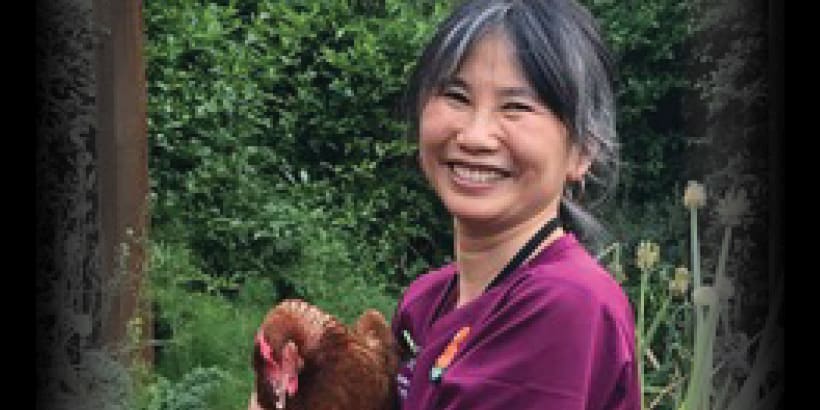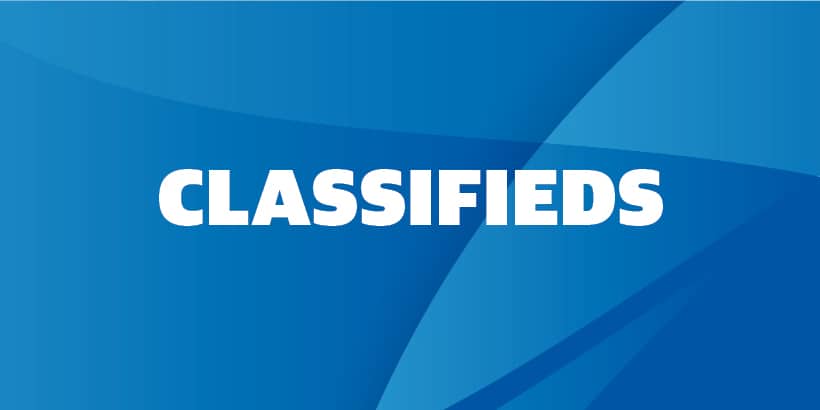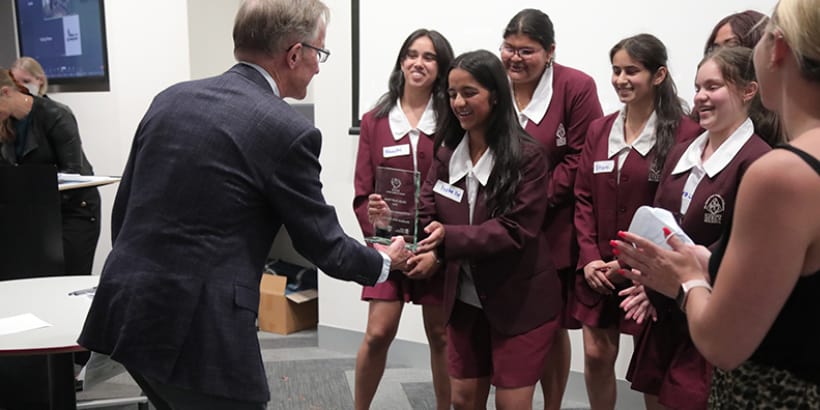
Heatwaves kill
January 19, 2023
Classifieds
January 19, 2023FEATURE
SALSA Youth Voices Actions in Western Sydney
The Students As Lifestyle Activists peer leadership program empowers students to become leaders and make better choices for their health.
Introduction
“Food insecurity is hidden behind a veil of shame and stigma and obscured by poor understanding and recognition in the community… particularly in western Sydney where the population is diverse, and so are the food and exercise habits.” – Year 10 student, Malek Fahd Islamic College
Childhood overweight and obesity is a significant public health issue in Australia and is associated with higher risks for the development of cardiovascular and metabolic diseases in adulthood [1, 2]. Major factors for the development of overweight and obesity include energy-dense diets, physical inactivity, poor sleep, having family members who are overweight, and exposure to marketing of unhealthy foods [1]. As highlighted by the student above, these factors are compounded in western Sydney by lower socio-economic status which is associated with lower education levels and a reduced awareness of what constitutes a healthy lifestyle [3-5].
Schools are effective settings for promoting physical activity and nutrition in adolescents and provide the opportunity for adolescents to improve health-related behaviours amongst their peers[6-9]. Efforts to promote physical activity and nutrition in adolescents through school-based programs is one way to ensure that students have the opportunity to be active and gain the skills required to choose healthy foods. However, this is challenging in the absence of environments, including infrastructure, which are supportive of and important for the use of those behaviours at school, home and in the community. The SALSA Youth Voices (SYV) program aims to bridge this implementation gap by empowering high school students to design and implement solutions. This helps to ensure a well-rounded and holistic approach.
SYV is an extension of the Students As LifeStyle Activists (SALSA) peer-leadership program, which is designed to motivate students to increase physical activity and healthy eating. The program applies a systems-based approach to address the socio-economic determinants of health by building the capacity of students to advocate for changes in their schools and create healthy supportive environments [5, 10, 11].
The concept of Youth Voice is about considering the perspectives, ideas, experiences, knowledge, and actions of young people. The cornerstone of Youth Voice programs is to create leadership opportunities for all young people – especially among those from socially disadvantaged communities whose voices are not heard often enough. When young people are given a voice through school-based programs like SALSA, it makes them feel they belong, their contributions matter and they are valued. Schools that incorporate Youth Voice programs help young people develop a range of social and emotional skills that prepare them for adulthood [12, 13].
The aim of the SYV Action Day is for peer-leaders to showcase their school actions plans and to get support from health and education professionals. The objectives of Action Day are to 1) communicate school action plans to a diverse range of stakeholders, 2) enhance confidence, communication, leadership, advocacy and teamwork skills in peer-leaders, and 3) provide opportunities for peer-leaders to receive feedback on their school actions.
Methodology
Year 10 students are trained as peer leaders and are provided further opportunities to enhance their leadership skills through SYV. The SALSA program and SYV is supported by a unique coalition of health, education, and sport communities who are strongly invested in the promotion of health in young people in western Sydney. SYV is comprised of two events, a Leadership Day held in term 3 and an Action Day held in term 4.
Leadership day
In 2022, we held the SYV Leadership Day workshop at the Department of Education, Parramatta. The workshop comprised of a combination of presentations, group discussions and interactive games/activities which addressed topics related to the importance of Youth Voice; identifying barriers and enablers to physical activity and healthy eating; and identifying skills required to develop a School Action Plan. Students are provided with resources to guide the planning, delivery and evaluation of their school interventions. Following small-group brainstorming, students present their ideas at the end of the workshop to their peers.
Action day
Following Leadership Day, we held SYV Action Day at Westmead Hospital for students to showcase their School Action Plans. At this event students present their proposed actions to an audience of invited health and education professionals to receive feedback and support for their ideas to improve opportunities for physical activity and/or nutrition within the school environment.
SYV evaluation
We conducted process and impact evaluation to determine (1) students’ confidence to implement their School Action Plan; (2) perceived skills gained from their participation in SYV; (3) factors which facilitated the development of their School Action Plan; and (4) perceived value of participating in SYV. Prior to the commencement of the Action Day workshop, students completed a brief online questionnaire. Students received feedback about their action plans from the audience through shout-out forms. Study data were collected and managed using the REDCap electronic data capture tool hosted at the University of Sydney [14]. Descriptive statistics were used to summarise the results.
Students and teachers were randomly interviewed to assess the implementation process and the impact of the program. Students were asked questions about what they learnt from their participation in SYV; the process in developing a School Action Plan; and changes they made to their diet and physical activity habits. Teachers were asked questions regarding their involvement in the development of students’ School Action Plans; perceived value of students’ participation; challenges encountered during the process; and suggestions for next time. Students were interviewed in their SALSA team groups and teachers were interviewed separately.
Results
Five high schools from western Sydney participated in the SALSA Youth Voices program. Four of the schools presented their School Actions Plans either virtually (N=1) or face-to-face (N=3). The fifth school sent in a video addressing the importance of food equity. A description of the students’ School Actions Plans, rationale and process are shown in Table.
All student School Action Plans received positive comments in the shout-out forms. Members of the audience (N=30) highlighted the public health value and challenges of students’ School Action Plans, for example:
“Good consideration of long-term and short-term impacts. Very funny and engaging video – I’m sold. Love that you have considered sustainability, planet health is also so important. Liked that you included past learnings and opportunities to learn from older and younger students.”
“Emphasis on physical activity. Great idea to have fruit cups. Very effective planning process with details. Realistic plan and should be a fun and informative event for the school”
“Great idea but funding is always the barrier”
Of the students who attended Action Day face-to face (N=17), fifteen students completed the evaluation survey. All students strongly agreed that they were confident in their ability to implement their School Action Plans in the near future. By participating in SYV, most students (N=14) believed they gained one or more skills in leadership (93%), teamwork (87%), communication (87%), confidence (80%), problem solving (60%), and advocacy (60%).
Factors identified as helping students to develop their School Action Plans included support from teachers (86%), teamwork (80%), being provided time in the school day to work on action plans (73%), feeling empowered (73%), support from school executives (53%) and support from the community (53%).
Most students strongly agreed that they found participating in SYV to be valuable.
Qualitative data from students and teachers indicated the SYV program to be well received by the school community and to produce significant benefits for participating students. Students reported that SYV enhanced their existing leaderships skills and perceived importance of exercising student voice.
“SALSA made our voices be heard. Other times we’ve spoken up and nothing has happened”
“We learnt how important it is to have a say …identifying issues important to your community”
By leading actions to increase opportunities for physical activity and nutrition in the school environment, students were also more conscious of improving the health behaviours of themselves and their family and friends.
“Now we’re more likely to eat fruit thinking about our presentation and the colour run”
“I’m walking more with my family like my dad and sister”
In addition to the benefits identified by students, teacher interviews highlighted that students learnt how to take initiative, advocate for others and the ability to work collaboratively. Importantly, students developed a stronger sense of community through their participation.
However, time, resource and financial constraints were identified as key challenges to the development and implementation of students’ actions.
“They gained camaraderie. Before this they were a disjointed group, now they bounce off each other and joke with each other.”
“A challenge was dialling down their expectations of what is possible within time frames and budget.”
Discussion
The School Action Plans developed by the peer leaders in 2022 have the potential to impact on current and future students. All four School Action Plans aimed to increase physical activity among all students at their school. Two of the School Action Plans involved the promotion of healthy eating alongside physical activity interventions. The strategies included a colour run and relining of school tennis courts, the installation of an outdoor gym, revamping the existing school gym, and a basketball tournament.
Most of the interventions required students to build advanced research skills including scoping the issues with other students at their school, developing the intervention, determining the cost, engaging appropriate stakeholders (e.g., school executives, groundskeeper) and sourcing external providers. Students also considered factors related to the feasibility and acceptability of their interventions including environmental impact, inclusivity, and funding.
It is apparent that by giving peer leaders ownership of the design and implementation of their own healthy lifestyle initiatives, that student actions have the capacity to add to existing initiatives in schools that reach and benefit whole school community. Moreover, SALSA Youth Voices enables the contributions of adolescents from socio-economically disadvantaged backgrounds to be valued and supported within the local community.
Despite the praises afforded to students for their efforts to develop sustainable and high impact School Action Plans, significant barriers to the implementation of these simple initiatives are time, resource and funding constraints. In a time of growing socio-economic disparity in Sydney, it is these actions presented by students which provide the opportunity for us to make lasting contributions towards bridging this gap.
Conclusion
Th evaluation of SALSA Youth Voices demonstrated that the actions developed by students produced far reaching benefits for both them and their school community. SYV are provided a unique opportunity for students from socio-economically disadvantaged areas to enhance their existing leadership skills and be agents of change to create a school environment which supports physical activity and healthy eating.
Acknowledgement
We thank the Australian Medical Association NSW for their ongoing funding support for the annual SALSA Youth Voices Action Day event. The audience and students greatly appreciated the lunch provided.
We would also like to acknowledge the funding support we receive from the Western Sydney Primary Health Network.
Article written by Catriona Lockett, Professor Smita Shah OAM, and Kym Rizzo Liu.
Table 2. Interventions, including rationale and outcomes designed (and described) by peer leader
| School # | Intervention | Rationale | Process |
| 1 | Colour Run Fruit Day (short-term project), and the relining of the tennis courts (long-term project) | To promote physical activity and healthy eating through one short-term and one long-term project.
To raise awareness of the social, physical and cognitive benefits of participating in leadership opportunities. |
This Colour Run Fruit Day is to be implemented by the students in term 4, 2022. Students will organise the run, distribute raffle tickets for sport equipment prizes, and prepare and distribute fruit cups.
The relining of the tennis courts is to be implemented in 2023 following approval from school executives. |
| 2 | Hoops 4 Hope | To promote healthy eating, physical activity and social wellbeing during an annual school basketball tournament.
|
The intervention is to be implemented by the students in term 4, 2022. Students will organise the sports equipment and coordinate a healthy BBQ for the basketball tournament. |
| 3 | The installation of an outdoor gym on school grounds | Most students did not meet the Australian guidelines for physical activity outside of school.
Lack of access to equipment and resources to engage in sufficient levels of physical activity. |
Students plan to hold themed fundraisers which promote healthy eating and/or physical activity in Term 1, 2023. The funds raised from these events will be used to purchase and install the outdoor gym equipment. |
| 4 | Revamp and update school gym for all students | To provide teachers and students with a supportive environment to improve mental health, physical activity, and social well-being. | The intervention is to be implemented in 2023 with assistance from the school executives, external contactors and students in the TAS (technological and applied sciences) and CAPA (creative and performing arts) faculties. |
References
- AIHW, Overweight and obesity among Australian children and adolescents 2020, Australian Government
- Daniels, S.R., The consequences of childhood overweight and obesity. The future of children, 2006. 16(1): p. 47-67.
- O’Dea, J.A., Gender, ethnicity, culture and social class influences on childhood obesity among Australian schoolchildren: implications for treatment, prevention and community education. Health & social care in the community, 2008. 16(3): p. 282-290.
- O’Dea, J.A. and P. Caputi, Association between socioeconomic status, weight, age and gender, and the body image and weight control practices of 6-to 19-year-old children and adolescents. Health education research, 2001. 16(5): p. 521-532.
- Shah, S., et al., A partnership for health: working with schools to promote healthy lifestyle. Australian family physician, 2011. 40(12): p. 1011-1013.
- Cullen, K.W., et al., Child-reported family and peer influences on fruit, juice and vegetable consumption: reliability and validity of measures. Health Education Research, 2001. 16(2): p. 187-200.
- Harden, A., A. Oakley, and S. Oliver, Peer-delivered health promotion for young people: a systematic review of different study designs. Health Education Journal, 2001. 60(4): p. 339-353.
- Hölund, U., Promoting change of adolescents’ sugar consumption: the ‘Learning by teaching’study. Health Education Research, 1990. 5(4): p. 451-458.
- Katz, D.L., School-based interventions for health promotion and weight control: not just waiting on the world to change. Annual review of public health, 2009. 30: p. 253-272.
- Shah, S., et al., The students as lifestyle activists (SALSA) program. British journal of sports medicine, 2017. 51(19): p. 1445-1446.
- Shrewsbury, V.A., et al., Impact and cost of the peer-led Students As LifeStyle Activists programme in high schools. Health Education Journal, 2020. 79(1): p. 3-20.
- Knowles-Yánez, K.L., Children’s participation in planning processes. Journal of Planning Literature, 2005. 20(1): p. 3-14.
- Mitra, D.L., The significance of students: Can increasing “student voice” in schools lead to gains in youth development? Teachers college record, 2004. 106(4): p. 651-688.
- Harris, P.A., et al., Research electronic data capture (REDCap)—a metadata-driven methodology and workflow process for providing translational research informatics support. Journal of biomedical informatics, 2009. 42(2): p. 377-381.

